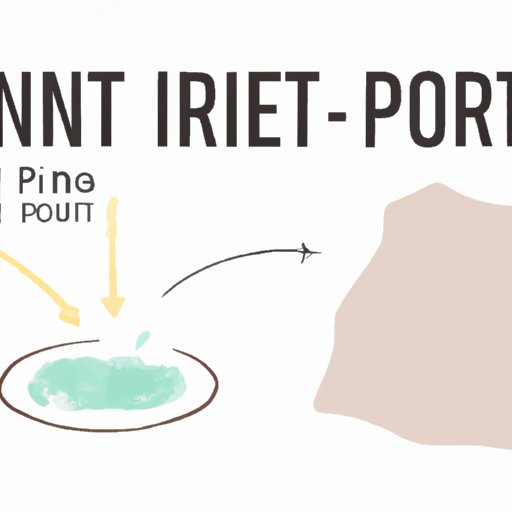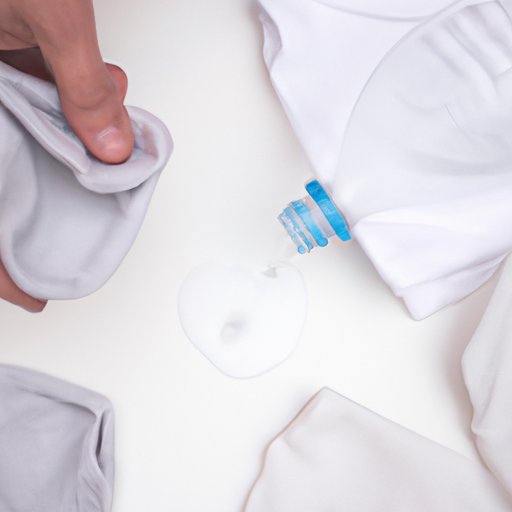I. Introduction
Hand washing clothes may seem like an old-fashioned, time-consuming task, but it can be a lifesaver when it comes to caring for your clothes. With machine washing often leading to shrinking, fading, and wear and tear, hand washing can help prolong your clothes’ lifespan. In this article, we’ll go over the basics of hand washing clothes, step-by-step guides for different fabric types, tips, and tricks for a more efficient wash, and much more. Let’s dive in!
II. The basics of hand washing clothes: A beginner’s guide
Hand washing clothes may sound intimidating, but it’s actually a simple and easy process that doesn’t require any expensive or fancy equipment. The benefits of hand washing clothes are many. For starters, it helps in retaining the quality and integrity of your clothes for longer periods. Secondly, it helps prevent shrinkage, fading, and fabric degradation over time. Third, it can save you money on your electricity and water bills when compared to using the washing machine.
To start with hand washing, you’ll need to prepare a few essentials. First, fill up a sink or washbasin with lukewarm water. Add a few drops of detergent in it.
Next, to prevent any damage to your clothes, it’s best to sort them by fabric type, color, and dirt level before washing.
Once you’ve sorted everything, it’s time to start washing.
Here are a few steps you should follow:
- Gently soak your clothes in the soapy water for five to ten minutes.
- Gently agitate the clothes by hand to help loosen dirt and grime.
- If necessary, apply some extra detergent to the stained areas and gently rub the fabric together.
- Rinse with cold water until the water runs clear.
- Press out the excess water (but do not wring).
- Lay the washed garment flat and straight to Air dry.
Now, let’s take a look at some tips that can help make your hand-washing process more efficient.
III. The step-by-step guide to hand washing clothes for a longer lifespan
While it’s always a good idea to start with the basics of hand washing clothes, you can go a step further with more in-depth techniques to ensure your clothes lose as little quality as possible. This is especially useful for clothes that are made of delicate fabrics and require a more gentle wash. Here are a few steps to follow.
Sorting Clothes By Fabric Types
Before you begin washing, it’s a good idea to separate different fabrics. This will prevent any damage to clothes made of a specific fabric when they are washed together with other fabrics.
Pre-treatment for Clothes With Stains
Irrespective of whether you are hand washing or using a washing machine, pre-treating any stains is essential. In case you notice a stain, apply some stain remover or detergent and let it sit for a few minutes before diving into the hand washing process.
Water Temperature & Amount of Detergent to Use
Make sure you are using the right amount of detergent. Too much detergent may lead to residue left on clothes, while too little of it may leave clothes unclean. You might also want to take into consideration the temperature of water you use to get optimal results. Some fabrics may require hotter water, while others might need to be washed in cold water.
Techniques to Hand Wash Clothes More Gently
Some helpful techniques that can be used to wash clothes more gently include using the least amount of agitation possible, decreasing soak time, and avoiding rubbing the fabric together rigorously.
IV. How to Properly Hand Wash Delicate Fabrics Such as Silk and Lace
When washing delicate fabrics such as silk and lace, it’s always best to hand wash, given the risk of damage in a washing machine. While it can seem intimidating, it’s easy once you know the right steps to take.
Explanation of Delicate Fabrics
Delicate materials include fabrics such as silk, lace, and cashmere, among others, that need extra care and attention during the washing process.
Ways to Identify Delicate Fabrics
It is essential to know which clothes require delicate care since washing them the wrong way could lead to significant damage.
The best way to identify a delicate fabric is by reading the care label, which provides instructions on how to clean a particular garment for optimal results.
Specific Steps to Hand Wash Delicate Clothes
Here are some specific steps to follow when washing delicate fabrics:
- Fill a basin or bowl with lukewarm water and add a few drops of a gentle, pH-balanced cleanser.
- Immerse the garment in the water and give it a gentle swirl.
- If there are stains, gently rub them with your fingers.
- Rinse the garment gently by running it under cool water until all the soap has been removed.
- Gently press the garment between your hands to get rid of excess water, but do not wring it out.
- Finally, roll the garment in a clean, dry towel to get rid of any remaining water and then gently reshape it, and lay it on a flat surface to dry.
Tips on How to Dry Delicate Clothes
To dry delicate fabrics, you’ll want to avoid the dryer and select a flat surface. Placing the garment inside a rolled-up towel can also be useful in removing excess moisture before air-drying.
V. The Benefits of Hand Washing Clothes and Reducing Your Carbon Footprint
Hand washing your clothes not only benefits the clothes themselves, but it can be an environmentally friendly option as well. Here are a few reasons why:
Advantages of Hand Washing Clothes
Hand washing clothes often involves less water than machine washing, which results in a lower carbon footprint. Additionally, it’s more cost-effective and helps preserve the quality of the clothing longer.
Comparison Between Hand Washing and Machine Washing
Machine washing clothes is faster and more convenient, but it is not always suitable for delicate or smaller clothes that can easily get tangled, tear apart or get completely damaged in a washing machine. Additionally, machine washing often requires more water than hand washing, and heavy-duty machines can be an energy drain.
Ways to Reduce Your Carbon Footprint by Hand Washing Clothes
If you want to reduce your carbon footprint, hand washing clothes is a great place to start. You can use eco-friendly detergents, reuse water, and use the sun to dry your clothes instead of a dryer – it’s an excellent way to save money on your electric bill too!
VI. The Best Laundry Detergent and Tools for Hand Washing Clothes
When it comes to hand washing clothes, selecting the right laundry detergent and tools can make or break the process.
Types of Laundry Detergent for Hand Washing Clothes
When buying laundry detergents for hand washing, you want to choose one that’s gentle on clothes. Some popular brands include detergents specifically for handwashing such as Woolite, Soak, The Laundress, and Eucalan. However, you can also use regular detergent as long as it’s intended for delicate fabrics.
Explanation of Different Washing Tools
Washing tools refer to the equipment you’ll use to hand wash your clothes. A basic set should include a washbasin or sink, measuring cups and spoons, a laundry basket, and clothespins.
Importance of Using Right Tools and Detergents
The right tools and detergents make all the difference when it comes to hand washing clothes. Not only do they help produce better results, but they also ensure that your clothes last longer.
VII. How to Dry Your Hand Washed Clothes Without Damaging Them
After washing your clothes, it’s important to dry them properly to ensure they maintain their shape and do not lose quality.
How to Wring Out Excess Water
You will want to wring out any excess water to reduce drying time and make the drying process a bit faster. However, avoid wringing the clothes too hard as this may cause damage to the clothes.
Drying Techniques for Different Fabric Types
Different fabrics require different drying techniques. For instance, when drying cotton clothes, you can hang them on a clothesline. On the other hand, laying woolen clothes flat to dry is a better method to prevent stretching, while silk should be hung to prevent wrinkles.
Tips on Drying Clothes Properly
Make sure clothes are thoroughly dry before storing them away. If clothes are only slightly damp and left in a closed drawer or closet, they might get a musty smell over time. Additionally, it’s a good idea to avoid hanging your clothes in the sun to dry to avoid fading their colors in the process. Instead, find a well-ventilated spot indoors to dry your clothes.

VIII. Troubleshooting Common Problems When it Comes to Hand Washing Clothes
When it comes to hand washing clothes, a few common issues can crop up that can be easily solved with some quick fixes.
How to Handle Clothes That Bleed Color
If you’re worried that clothes are going to bleed color, it’s a good idea to wash them separately. In the event of bleeding color, you can add a tablespoon of white vinegar to the rinse water, or use a commercial color catcher to ensure colors stay intact.
Tips to Remove Wrinkles and Creases
Taking clothes out of the wash and hanging them up or laying them flat to dry is a quick fix for preventing creases from forming. In case creases or wrinkles do form, you could lightly iron them out using a low heat iron.
Strategies for Dealing With Clothes That Shrink
To avoid clothes from shrinking, make sure to check out the instructions on the clothing label before washing. If you end up shrinking clothes, you might still be able to stretch them out by soaking them in warm water for a few minutes and manipulating them gently.
IX. Conclusion
We hope this guide has been helpful in learning how to better care for your clothes by hand washing them. Remember, understanding how to properly hand wash clothes protects your wardrobe in the long run and preserves the dress for a longer lifespan. So, rather than having to replace your favorite clothes every few months, you can keep them for years to come.
So, go ahead and take the first step towards a more eco-friendly and cost-effective way of caring for your clothing. Say goodbye to machine-washed clothes and hello to hand-washing your clothes from now on!
Call to Action: Start Hand Washing Your Clothes Today
Now that you know everything there is to know about hand washing clothes, it’s time to get down to business.
